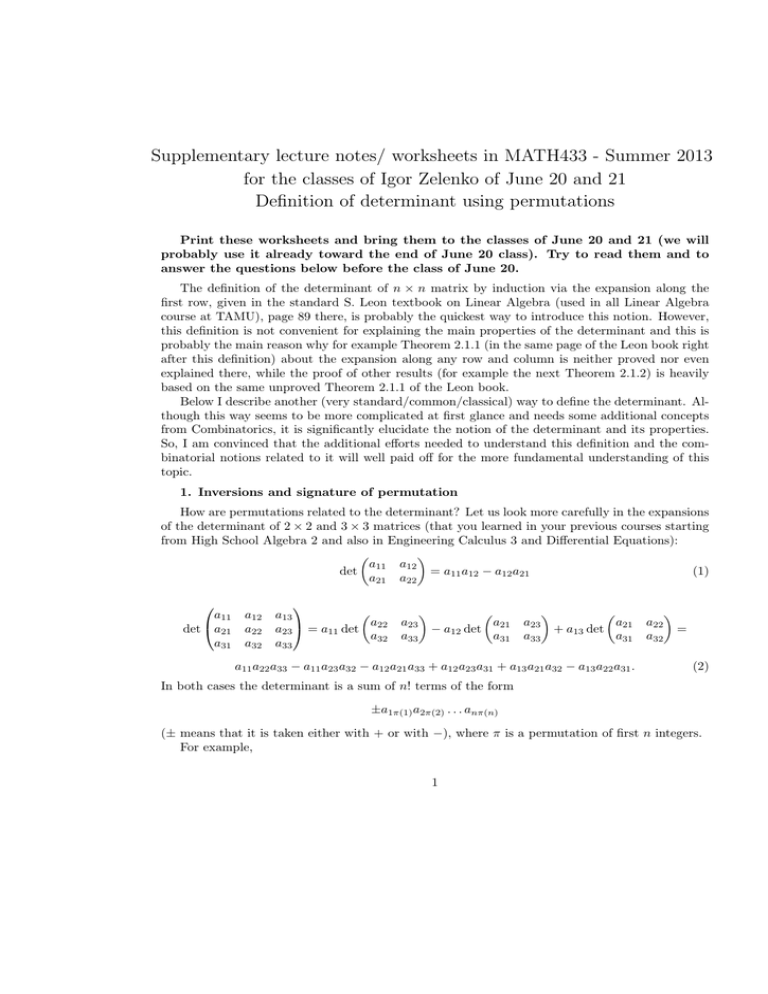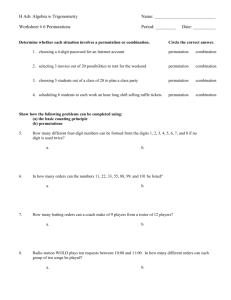Supplementary lecture notes/ worksheets in MATH433 - Summer 2013
advertisement

Supplementary lecture notes/ worksheets in MATH433 - Summer 2013
for the classes of Igor Zelenko of June 20 and 21
Definition of determinant using permutations
Print these worksheets and bring them to the classes of June 20 and 21 (we will
probably use it already toward the end of June 20 class). Try to read them and to
answer the questions below before the class of June 20.
The definition of the determinant of n × n matrix by induction via the expansion along the
first row, given in the standard S. Leon textbook on Linear Algebra (used in all Linear Algebra
course at TAMU), page 89 there, is probably the quickest way to introduce this notion. However,
this definition is not convenient for explaining the main properties of the determinant and this is
probably the main reason why for example Theorem 2.1.1 (in the same page of the Leon book right
after this definition) about the expansion along any row and column is neither proved nor even
explained there, while the proof of other results (for example the next Theorem 2.1.2) is heavily
based on the same unproved Theorem 2.1.1 of the Leon book.
Below I describe another (very standard/common/classical) way to define the determinant. Although this way seems to be more complicated at first glance and needs some additional concepts
from Combinatorics, it is significantly elucidate the notion of the determinant and its properties.
So, I am convinced that the additional efforts needed to understand this definition and the combinatorial notions related to it will well paid off for the more fundamental understanding of this
topic.
1. Inversions and signature of permutation
How are permutations related to the determinant? Let us look more carefully in the expansions
of the determinant of 2 × 2 and 3 × 3 matrices (that you learned in your previous courses starting
from High School Algebra 2 and also in Engineering Calculus 3 and Differential Equations):
a
a12
det 11
= a11 a12 − a12 a21
(1)
a21 a22
a11
a
det
21
a31
a12
a22
a32
a13
a
a23 = a11 det 22
a32
a33
a23
a33
a
− a12 det 21
a31
a23
a33
a
+ a13 det 21
a31
a11 a22 a33 − a11 a23 a32 − a12 a21 a33 + a12 a23 a31 + a13 a21 a32 − a13 a22 a31 .
a22
a32
=
(2)
In both cases the determinant is a sum of n! terms of the form
±a1π(1) a2π(2) . . . anπ(n)
(± means that it is taken either with + or with −), where π is a permutation of first n integers.
For example,
1
• the
a11 a22 in the right hand side of equation (1) corresponds to the identity permutation
term 1 2
and it is taken with +,
1 2
• the terma12 a21 in the right hand side of equation (1) corresponds to the permutation
1 2
and it is taken with −,
2 1
• the term a13a21 a32 in the right hand side of equation (2) corresponds to the permutation
1 2 3
and it is taken with +,
3 1 2
Question 3. To what permutation does the term a13 a22 a31 in the right hand side of equation
(2) correspond?
Note that it is taken with − there.
The key point is that the same expansion of the determinant is valid for general n. The big
question is: With what sign, + or −, the term a1j1 a2j1 . . . anjn should be taken?
In order to answer this question we need the following
Definition 1. A pair of numbers (π(k), π(l)) in the permutation π is called an inversion if k < l
and π(k) > π(l). In other words, if a larger number precedes a smaller one in the second row of
the 2 × n matrix of the permutation then these two numbers create an inversion.
Definition 2. The number
sgn(π) = (−1)# of inversions in π
is called the signature of the permutation π. In other words,
(
1
if #of inversions in π is even
sgn(π) =
−1 if #of inversions in π is odd
In the first case the permutation is called even and in the second case it is called odd.
Remark 1. The last definition is almost immediately equivalent to the definition on page 165 of
Humphreys& Prest (think why?). Our definition is just more elementary and more applicable. The
definition in the textbook is more adapted for the subsequent proofs there (for example, of Theorem
4.2.8 there. We will use another strategy and order for proving the same.
For example,
• In the permutation
1
1
2
2
there is no inversion, so it is an even permutation and its
signature is 1;
2
1 2
• In the permutation
there is 1 inversion: (2, 1), so it is an odd permutation and
2 1
the signature of it is equal to −1;
1 2 3
• In the permutation
the inversions are (3, 1) and (3, 2). So, there are 2 inver3 1 2
sions, the permutation is even and its signature is equal to 1;
1 2 3
Question 4. Given the permutation
3 2 1
• List all its inversions:
• Decide whether it is an even or odd permutation:
• Find its signature:
Question 5. Given the permutation
1
3
2
4
3
2
4
1
• List all its inversions:
• Decide whether it is an even or odd permutation:
• Find its signature:
Question 6. Given the permutation
1
5
2
2
3
1
4
4
5
3
• List all its inversions:
• Decide whether it is an even or odd permutation:
• Find its signature:
Now we are ready to give the general definition of the determinant:
Definition 3. Given an n × n matrix A = (aij ) the determinant det(A) is the following number
X
det(A) :=
sgn(π)a1π(1) a2π(2) . . . anπ(n)
(3)
π∈S(n)
In other words, the sign of the term a1π(1) a2π(2) . . . anπ(n) in the expansion of the determinant is
equal to the signature of the permutation π.
3
Question 7. Show that Definition 3 matches our previous definition of the determinant
• for n = 2
• for n = 3
I will explain on the whiteboard why the inductive definition via the expansion along the first
row given previously matches Definition 3 (take the notes in your notebook).
Question 8. Let A = (aij ) be a 5 × 5 matrix. Determine with what sign appear the term
a15 a21 a32 a44 a53 in the expansion of the determinant of A: For this you need to answer the following
questions:
• To what permutation (of first 5 integers) does this term correspond?
• List all inversions of this permutation:
• What is the signature of this permutation and therefore the answer to the original question?:
The expansion (3) is not convenient for calculation of the determinant: you need to perform
n · n! multiplications and n! − 1 additions/subtractions in order to do that ( figure out what are
these numbers already for n = 5) but it is very convenient in order to understand the properties
of the determinant and in this way to justify other, more efficient ways for calculations of the
determinant (based on the row/column operations).
2. Signature via transpositions
Recall that a transposition is a cycle of length 2. A transposition (i i + 1), i.e. with adjacent
numbers swapped, is called elementary or adjacent transposition.
Proposition 1. The product of a permutation π on a transposition τ change the signature of π,
i.e sgn(πτ ) = −sgnπ.
Proof.
1. If τ is an elementary transposition then the numbers of inversion of π and πτ differs by
1 . Indeed, the set {πτ (1), . . . πτ (n)} is obtained from the set {π(1), . . . π(n)} by swapping two
adjacent elements. If you swap two adjacent elements in {π(1), . . . π(n)} such that the larger one
was on the right, then one new inversion is created (and the rest remains the same) and if you
swap two adjacent elements such that initially the larger one was on the left, then one inversion
4
disappears (and the rest remains the same). So, in both cases the parity of the permutation
changes.
2. Any transposition is a product of an odd number of elementary transpositions. Indeed, if
k < l then
(k l) = (k k + 1) . . . (l − 2 l − 3)(l − 1 l − 2) (l l − 1) . . . (k + 1 k + 2)(k k + 1),
{z
}|
{z
}
|
l−k−1times
l−k−1times
so (k l) is the product of 2(l − k) − 1 elementary transpositions. For example for n ≥ 5
(2 5) = (2 3)(3 4)(4 5)(3 4)(2 3)
and (2, 5) is a product of 5 elementary transpositions. By part 1 of the proof, the multiplication
(from the right) by an elementary transposition changes the parity of the permutations. Therefore
the product of odd number of elementary transpositions is an odd permutations (note that the
identity permutation is even).
Using Definition 3 and Proposition 1 it is almost immediate to show that interchanging
any row in a matrix changes the sign of the determinant, then also to prove the part of
(unproved) Theorem 2.1.1, page 89 of Leon book regarding the expansion along an arbitrary row
and other properties listed in sections 2.1 and 2.2
Note that any cycle is a (nonunique) product of (in general nondisjoint) transpositions. Therefore by cycle decomposition Theorem (Theorem 4.1.3 of our textbook) any permutation π is a
(nonunique) product of (in general nondisjoint) transpositions. Although such decomposition of a
permutation in a product of transposition is not unique and, in particular, the number of transposition in different decompositions of the same permutation might be different, this number modulo
2 is the same, because by the previous proposition the parity of this number is equal to the parity
of π, i.e. the parity of the number of inversions in π.
Using the latter fact one can prove almost immediately the part of (unproved) Theorem 2.1.1,
page 89, of the Leon book regarding the expansion along an arbitrary column which in turn shows
that all properties of the determinant related to the row operations are automatically valid for the
corresponding column operations.
Corollary 1. The following identity holds:
sgn(πσ) = sgn(π)sgn(σ).
Hint: Use a decomposition of a permutation into the product of transpositions and Proposition
1 appropriate number of times.
5








